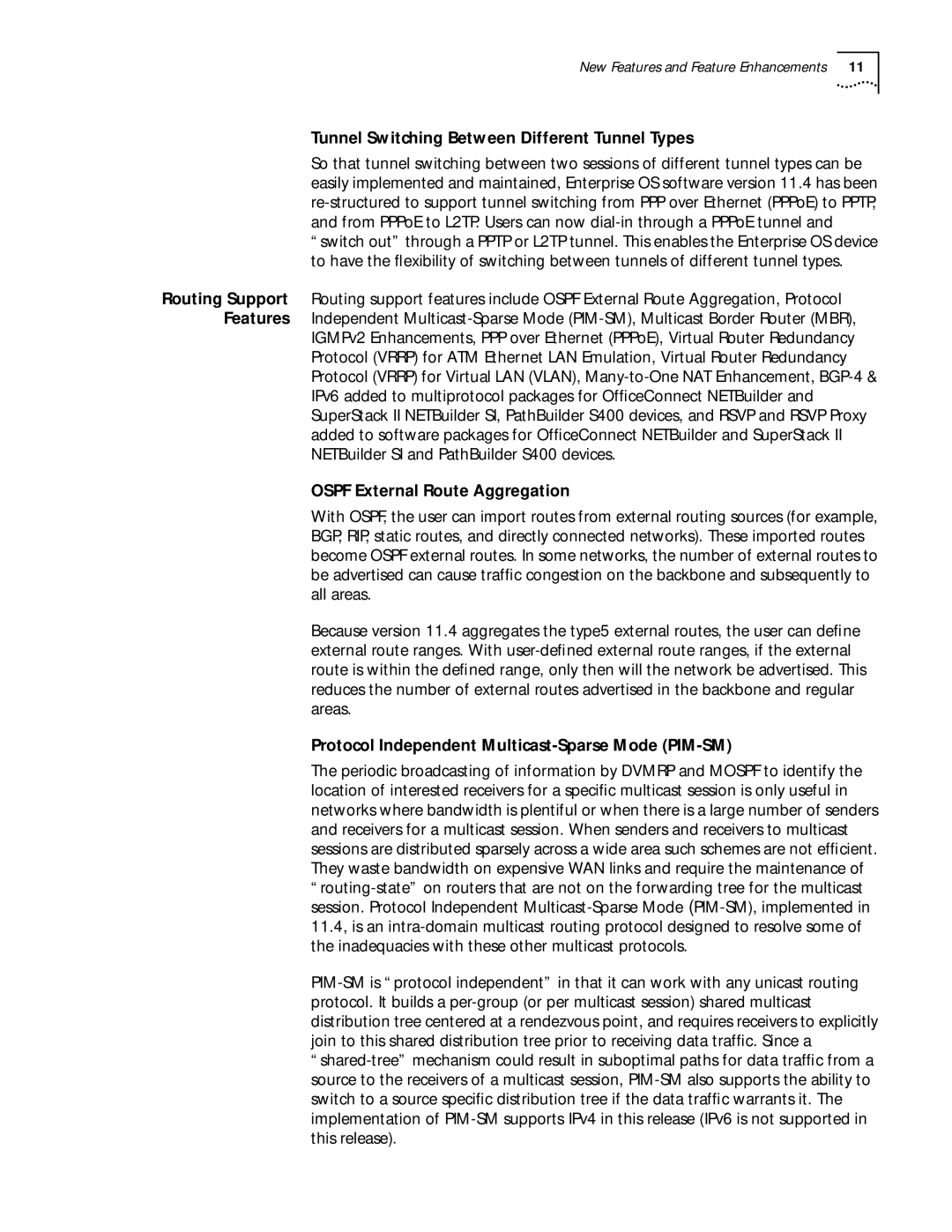New Features and Feature Enhancements 11
Tunnel Switching Between Different Tunnel Types
So that tunnel switching between two sessions of different tunnel types can be easily implemented and maintained, Enterprise OS software version 11.4 has been re-structured to support tunnel switching from PPP over Ethernet (PPPoE) to PPTP, and from PPPoE to L2TP. Users can now dial-in through a PPPoE tunnel and “switch out” through a PPTP or L2TP tunnel. This enables the Enterprise OS device to have the flexibility of switching between tunnels of different tunnel types.
Routing Support Routing support features include OSPF External Route Aggregation, Protocol Features Independent Multicast-Sparse Mode (PIM-SM), Multicast Border Router (MBR),
IGMPv2 Enhancements, PPP over Ethernet (PPPoE), Virtual Router Redundancy Protocol (VRRP) for ATM Ethernet LAN Emulation, Virtual Router Redundancy Protocol (VRRP) for Virtual LAN (VLAN), Many-to-One NAT Enhancement, BGP-4 & IPv6 added to multiprotocol packages for OfficeConnect NETBuilder and SuperStack II NETBuilder SI, PathBuilder S400 devices, and RSVP and RSVP Proxy added to software packages for OfficeConnect NETBuilder and SuperStack II NETBuilder SI and PathBuilder S400 devices.
OSPF External Route Aggregation
With OSPF, the user can import routes from external routing sources (for example, BGP, RIP, static routes, and directly connected networks). These imported routes become OSPF external routes. In some networks, the number of external routes to be advertised can cause traffic congestion on the backbone and subsequently to all areas.
Because version 11.4 aggregates the type5 external routes, the user can define external route ranges. With user-defined external route ranges, if the external route is within the defined range, only then will the network be advertised. This reduces the number of external routes advertised in the backbone and regular areas.
Protocol Independent Multicast-Sparse Mode (PIM-SM)
The periodic broadcasting of information by DVMRP and MOSPF to identify the location of interested receivers for a specific multicast session is only useful in networks where bandwidth is plentiful or when there is a large number of senders and receivers for a multicast session. When senders and receivers to multicast sessions are distributed sparsely across a wide area such schemes are not efficient. They waste bandwidth on expensive WAN links and require the maintenance of “routing-state” on routers that are not on the forwarding tree for the multicast session. Protocol Independent Multicast-Sparse Mode (PIM-SM), implemented in 11.4, is an intra-domain multicast routing protocol designed to resolve some of the inadequacies with these other multicast protocols.
PIM-SM is “protocol independent” in that it can work with any unicast routing protocol. It builds a per-group (or per multicast session) shared multicast distribution tree centered at a rendezvous point, and requires receivers to explicitly join to this shared distribution tree prior to receiving data traffic. Since a “shared-tree” mechanism could result in suboptimal paths for data traffic from a source to the receivers of a multicast session, PIM-SM also supports the ability to switch to a source specific distribution tree if the data traffic warrants it. The implementation of PIM-SM supports IPv4 in this release (IPv6 is not supported in this release).
